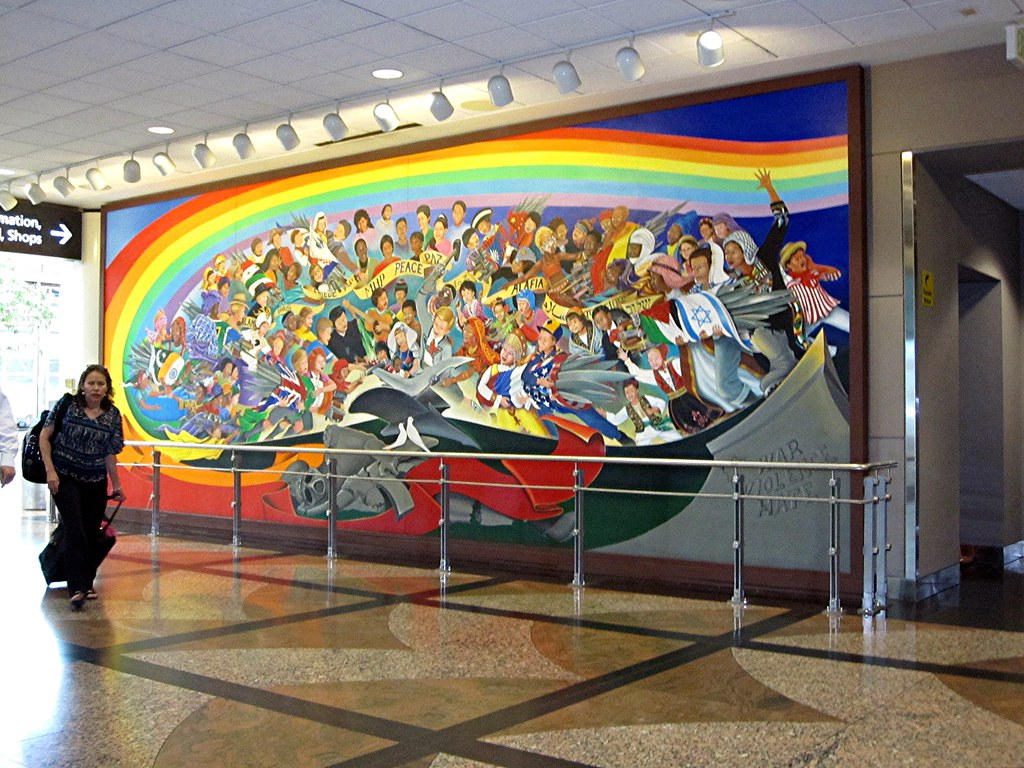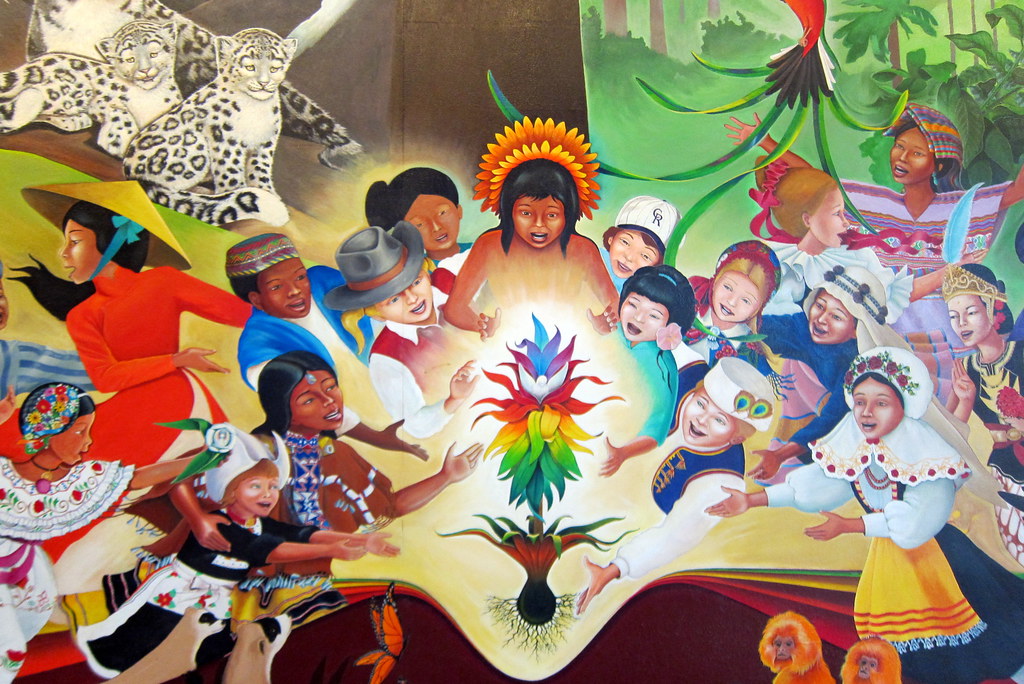As an online entrepreneur who’s fortunate enough to travel the globe, I’ve experienced my fair share of airports. From the sleek efficiency of Tokyo’s Narita to the palatial opulence of Dubai International, each airport has its own distinct charm—or lack thereof. However, no airport has captured my curiosity and imagination quite like Denver International Airport (DIA). It’s not just a hub for passengers; it’s a destination in and of itself.
DIA isn’t merely a massive structure of runways and terminals, nor just a waypoint on my many adventures. The airport stands as a canvas of conspiracy theories, massive public art installations, and especially its captivating murals. Whether you’ve heard the whispers about the underground bunkers or you’ve seen images of the strange, almost dystopian murals circulating online, there’s no denying it: DIA is unique.
The Fascinating Origins of DIA
Before we dive into the visual art that lines the walls of the airport, let’s set the stage. DIA opened in 1995, years behind schedule and significantly over budget. This, in turn, sparked rumors about secret underground facilities, theories about the New World Order, and even discussions about hidden messages encoded in the airport’s blueprints. As a traveler who enjoys a good mystery, I couldn’t resist investigating on one of my many trips to Colorado.
The airport’s layout itself is immense, covering more ground than any other airport in the United States. Driving up to it, you’ll immediately notice the iconic white, peaked roof, resembling the Rocky Mountains in the distance. But beyond its size and architecture, it’s the airport’s art that caught my attention on my first visit—and kept me coming back to dig deeper.
Denver Airport Murals: Art or Prophecy?
One of the first things you’ll notice in the terminal is a series of murals, many of which are painted by local artist Leo Tanguma. These murals are striking, both in scale and subject matter. As a lover of art and symbolism, I couldn’t help but be mesmerized by their bold, almost ominous nature.
“Children of the World Dream of Peace”
This two-part mural spans multiple panels and presents a narrative that seems to depict both destruction and harmony. In one section, you see a disturbing image of a military figure in a gas mask, wielding a sword over what appears to be dead children and crumbling buildings. The colors are dark, the mood unsettling. As someone who’s experienced different parts of the world, this part of the mural evokes scenes of war-torn areas or authoritarian regimes. It’s impossible not to feel a sense of foreboding.
But then, the mural shifts dramatically. In the second section, children from various nations are shown in vibrant colors, gathering around what seems to be a glowing flower. The contrast is stark, as if symbolizing the possibility of peace after a period of great suffering. This shift in tone raises questions: Is the mural a warning? Or a hopeful prophecy for a better future? While some say it’s a simple reflection on war and peace, others believe it hints at larger, more cryptic themes.

“In Peace and Harmony with Nature”
Another mural that dominates the space at DIA is “In Peace and Harmony with Nature.” This artwork shows scenes of environmental destruction, with animals in glass cages and a forest burning in the background. Again, the theme is somber and apocalyptic. However, in the latter portion of the mural, harmony is restored, with humans coexisting peacefully with nature.
Given my passion for sustainable agriculture and global projects, this mural speaks to me on a personal level. It’s a commentary on our relationship with the environment—a reminder of both the destruction we’ve caused and the hope for renewal. Yet, it also raises questions. The sharp juxtaposition between chaos and serenity can feel like an allegory for something deeper. Some speculate it’s a warning about climate change, while others weave it into more far-reaching theories about the future of humanity.

Theories and Speculations: More Than Just Art?
As someone who’s read plenty of online forums, the conspiracy theories around these murals are hard to ignore. You can almost feel the hidden messages jumping out at you if you let your mind wander. Are these murals a simple reflection of universal themes like peace, war, nature, and harmony? Or are they something more?
Rumors abound about DIA being a secret base for the elite or a doomsday bunker. Some believe the murals are clues pointing to an impending global event or an emerging New World Order. Others point to the plaques and sculptures throughout the airport—like the blue mustang statue outside (infamously nicknamed “Blucifer”)—as further evidence that there’s something strange afoot.
Blucifer, with its glowing red eyes and ominous stance, certainly adds to the airport’s enigmatic aura. The fact that it killed its sculptor, Luis Jiménez, during construction only adds to the eerie speculation.
Of course, as a rational traveler, I know it’s easy to get swept up in these narratives. But whether you believe in the conspiracy theories or not, there’s no denying that the art at DIA engages the viewer in a profound way. It makes you think. It invites you to question the world around you—and perhaps that’s the point.
Public Art: A Global Phenomenon
One of the reasons I find the DIA murals so compelling is because of their role in a much larger movement. Public art is a global phenomenon. From the graffiti-covered walls of Berlin to the towering sculptures of New York City’s parks, art outside of traditional galleries tells stories, challenges norms, and often becomes intertwined with the identity of the cities that host it.
As an entrepreneur who spends much of his life on the road, I often find that public art can offer a unique insight into a city’s culture. In Denver’s case, these murals give visitors a sense of the city’s ambition and its willingness to engage with complex, often uncomfortable, topics. The art isn’t there to just be admired; it’s there to provoke thought.
A Must-See for Travelers
Whether you’re catching a connecting flight or staying in Denver for a while, I highly recommend taking some time to explore the art at DIA. The murals are scattered throughout the Jeppesen Terminal and Concourse B, and there’s even a guided tour if you’re particularly interested in diving deeper into the backstory of each piece. It’s a unique experience, offering a moment of introspection between flights or a reason to linger longer than planned.
Beyond the art, DIA also offers a surprisingly rich array of dining and shopping options, many of which highlight local Colorado businesses. It’s a fantastic way to get a taste of Denver’s culture without leaving the airport. For those of us who like to blend work and travel, DIA even has comfortable lounges and workspaces, ensuring that you can stay productive while pondering the deeper meanings of the murals around you.
Final Thoughts
In my years of traveling, I’ve encountered many airports, but Denver International Airport stands out not just for its size and architecture but for its art. The murals, in particular, offer more than just visual appeal. They are a complex mix of beauty and unease, of hope and despair. Whether you believe they’re part of a grander conspiracy or simply reflections on the human experience, they are undeniably thought-provoking.
So, the next time you’re at DIA, don’t just rush to your gate. Take a moment to pause and consider the art around you. After all, airports are more than just transient spaces; they are crossroads of human stories. And at DIA, those stories are told through paint and canvas in a way that’s unlike anywhere else in the world.

Leave a Reply